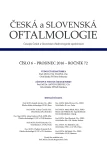AMNIOTIC MEMBRANE APPLICATIONS – OUR EXPERIENCE
Authors:
I. Krčová 1; M. Stanislavová 1; K. Peško 1; A. Furdová 1; J. Koller 2
Authors‘ workplace:
Klinika oftalmológie LF UK a UN Ružinov, Bratislava
1; Klinika popálenín a rekonštrukčnej chirurgie LFUK a UN a Centrálna tkanivová banka, Bratislava
2
Published in:
Čes. a slov. Oftal., 72, 2016, No. 6, p. 204-208
Category:
Original Article
Overview
Introduction:
Amniotic membrane is the innermost part of the fetal and packaging for its exceptional qualities likes to be used in treating many ocular pathologies. Amniotic membrane has improved the ability to treat ocular surface disease. It has unique features like support conjunctival and corneal epithelialization.
Material and methods:
Retrospective analysis of group patients who underwent amniotic membrane transplantation at the Department of Ophthalmology Faculty of Medicine and UN Bratislava in 2013–2015. We evaluated indications amniotic membrane transplantation, the percentage, the number of transplants and the number of failures and retransplantation of the membrane.
Results:
In group of 71 patients (amniotic membrane covering defects of conjunctiva and cornea) male patients formed a slight predominance of males in the number of patients a slightly larger preponderance in 38 women (53.5 %) – 52 surgeries (59.09 %) and 33 male (46.5 %) in 36 interventions (40.91 %). The left eye was affected in 40 interventions (45.45 %), 48 interventions were on the right eye (54.54 %). The most common cause application of 30.68 % in 27 eyes was corneal ulcer, bullous keratopathy followed by the 11.36 % in 10 eyes, and the ulcer herpetic keratitis in 9.10 % in 8 eyes. Injury or vulnus penetrans 6.82 % in 6 eyes, ulcers caused by paresis n. facialis 6.82 % in 6 eyes and sicca syndrome 5.68 % in 5 eyes.
In 2015 we applied amniotic membrane covering the defect of eyelids after trauma in one patient.
Conclusion:
Amniotic membrane is the appropriate treatment in a number of diseases of ocular surface when conservative methods of treatment fail. In corneal application can prevent the execution of more aggressive treatment, such as keratoplasty, or to soothe inflammation and keratoplasty is not performed as emergent, but elective.
Key words:
amniotic membrane transplantation, eye diseases
Sources
1. Arora R., Mehta D., Jain V.: Amniotic membrane transplantation in acute chemical burns. Nature Publishing Group. Eye 2005; 19 : 273–278.
2. Baradaran-Rafii A., Aghayan H., Arjmand B., Javadi MA.: Amniotic Membrane Transplantation, Iran J Ophtalmic Res 2007; 2(1): 58-75.
3. Dua HS., Azura-Blanco A:. Amniotic membrane Transplantation, Br J Ophtalmol 1999; 83 : 748 - 752.
4. Dua HS., Gomes JAP., King AJ., Maharajan VS.: The Amniotic Membrane in Ophthalmology. Survey of Ophtalmology 2004; 49 (1):51 - 77.
5. Furdová A., Kalužáková A., Amrich M., Mozolík P.: Ochorenia spojovky a rohovky - vybrané kapitoly. 1. vyd. Bratislava; Univerzita Komenského 2016 : 155 s. ISBN 978-80-223-4174-5. Dostupné na: http://www.fmed.uniba.sk/fileadmin/lf/sluzby/akademicka_kniznica/PDF/Elektronicke_knihy_LF_UK/Ochorenia_spojovky_a_rohovky_Furdova.pdf.
6. Gris O., Campo Z., Wolley-Dod CH., Güell JL., Bruix A, Calatayud M, Adán A.: Amniotic Membrane Implantation as a Therapeutic Contact Lens for the Treatment of Epithelial Disorders. Cornea 2002; 21(1): 22–27.
7. Grueterich M., Tseng SC.: Human limbal progenitor cellsexpanded on human amniotic membrane ex vivo. Arch Ophthalmol 2002;120 : 783–790.
8. Lee SH., Tseng SC.: Amniotic membrane transplantation for persistent epithelial defects with ulceration. Am J Ophthalmol 1997; 123 : 303–12.
9. Letko E., Ttechschulte SU., Kenyon K.R. et al.: Amniotic Membrane Inlay and Overlay Grafting for Corneal Epithelial Defects and Stromal Ulcers. Arch Ophthalmol 2001; 119 : 659–663.
10. Mamede AC., Botelho MF.: Amniotic membrane, Origin, Characterization and Medical Applications, Springer; 1st ed. 2015 edition, 254p, ISBN 978-94-017-9975-1.
11. Nakamura T, Yoshitani M, Rigby H. et al. Sterilized, freeze-dried amniotic membrane: a useful substrate for ocular surface reconstruction. Invest Ophthalmol Vis Sci 2004; 45 : 93–99.
12. Niknejad H., Peirovi H., Jorjani M., Ahmadiani A., Ghanavi J, Seifalian AM.: Properties of the amniotic membrane for potential use in tissue engineering. European Cells and Materials 2008 15 : 88-99. ISSN 1473–2262.
13. Pinnita P., Nattaporn T., Wiwat, K.: Single and multilayer amniotic membrane transplantation for persistent corneal epithelial defect with and without stromal thinning and perforation. Br J Ophthalmol 2001; 85 : 1455–1463.
14. Seitz B., Das S., Sauer R., Mena, D., Hofmann-Rummelt C.: Amniotic membrane transplantation for persistent corneal epithelial defects in eyes after penetrating keratoplasty. Eye (2009) 23, 840–848. Dostupné na: http://www.nature.com/eye/journal/v23/n4/full/eye2008140a.html#tbl2.
Labels
OphthalmologyArticle was published in
Czech and Slovak Ophthalmology

2016 Issue 6
Most read in this issue
- Central Serous Chorioretinopathy as a Masquerading Syndrome of Choroidal Hemangioma
- Difficult Diagnosis of Non-strabismic Binocular and Accommodative Disorders
- AMNIOTIC MEMBRANE APPLICATIONS – OUR EXPERIENCE
- Disorders of Simple Binocular Vision in Heterophoria and their Spectacle Correction
